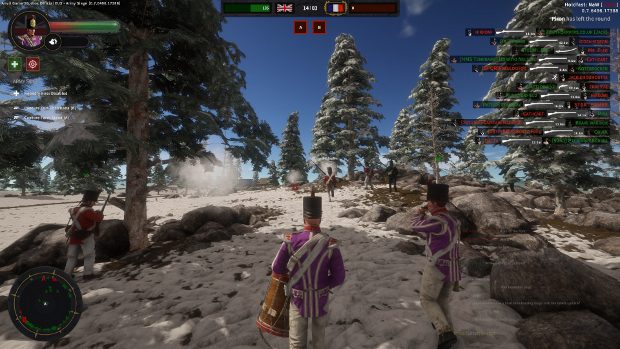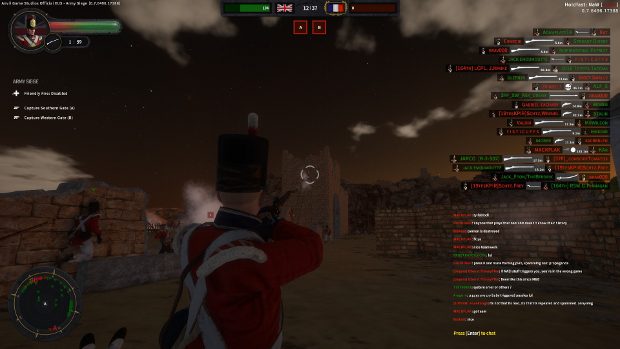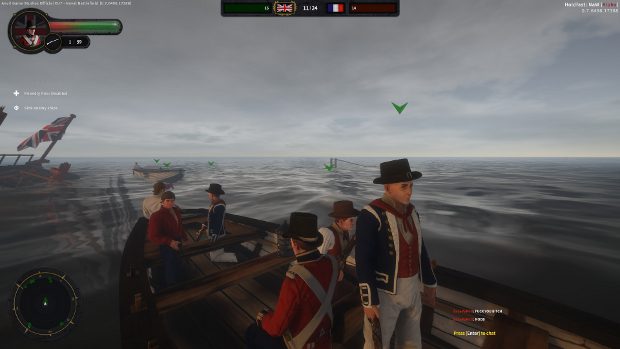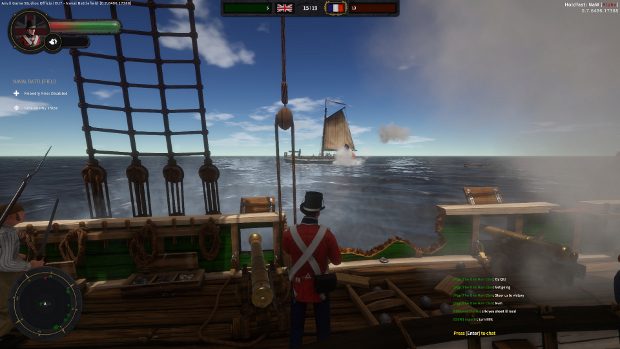Premature Evaluation: Holdfast - Nations At War
Little Drummer Boy
We’ve been sending Fraser off to explore Early Access games. He keeps coming back. This week, he’s been standing in a neat row with new friends while 18th century Frenchmen shoot at him in Holdfast: Nations At War [official site].
During my sojourn in the Napoleonic era, I have seen some terrible things. I watched as an officer yelled at his troops to stand in a neat line, not realising that they’d all been killed by artillery. I witnessed 20 bold soldiers charge across a tiny bridge, all slaughtered before they got the other side. From my hiding spot behind a tree, I saw my allies cut down by screaming Frenchmen who burst out of the darkness, sabres held high. And throughout it all, I drummed.
Holdfast has a lot of classes, from the sort of things you'd expect in a multiplayer shooter, like infantry, to command and support classes, like officers, surgeons and even carpenters. Those classes are not for me. I want to bring a smile to the faces of terrified soldiers; I want to spur them on, inspiring them to do incredible things. I always knew that two years of drum lessons would pay off.
As I spawned into a battle well underway, with British forces attempting to push past the final French fortifications, I found myself ill-equipped to handle the baying hordes of enemies. My pistol was terrible, and I didn’t even get to use my sabre before I was shot in the face. Not an auspicious beginning to my drumming career.
My second attempt proved more fruitful. Instead of taking potshots with my awful pistol, I started making sweet music. From a surprisingly robust list of tunes, from Spanish Ladies to a simple drum roll, I picked Scotland the Brave, which made me feel exceedingly patriotic. As cannonballs flew past my head and bullets hammered the trees in front of us, my allies were bolstered by my magical music, becoming healthier and taking less time to reload their firearms. Given that it takes a hundred years to load these 18th century guns, this is particularly handy.
“This is marvelous,” I thought to myself, as I tapped my feet to the beat of the drum. And then I got shot in the face again. The problem was that I didn’t have enough bodies in front of me to block all the horrible bullets. So I found myself some pals.
Unlike, say, Battlefield 1, Holdfast doesn’t drop you into squads, but that’s where the people who take playing officers very seriously come in. Everyone can use the proximity-based voice chat, but officers can also issue commands that are both voice acted and displayed as messages to the rest of the army, calling on reinforcements or getting people to charge, increasing their damage.
So I’d just respawned, and I was looking for some new buddies, when I heard an officer barking orders. “OK, stand in a line! No! You, near the tree, get over here! Thank you! Now, on my mark, charge!” And we did. We sprinted across that field, smoke in our eyes, cannonballs whizzing past, the cacophony of battle all around us. Shouting. Calling for help. Explosions. The Lord of the Rings theme playing over voice chat.
By the time we reached the objective, two thirds of our group were dead, including our officer. The rest of us didn’t fare much better. Drums do not, lamentably, bring back the deceased. There weren’t enough of us to justify more music, so I fired my pistol and took out a Frenchman protecting some artillery. With no time to reload, I charged at his friend, shouting as I gripped my sabre (and mouse). I fell to the ground before I reached him. Our glorious attack had failed.
That’s how most of my fights went. These battles are all about attrition. As an attacker, the goal is to whittle down the enemy defenses and reduce their spawn tickets through an unrelenting, sustained assault. At times it can feel futile, and aside from the spawn ticket indicator, it can be hard to get a sense of how the battle is going, but so far I’ve just been happy to potter about the battlefield, joining infantry lines, marching where I’m ordered, backing up my pals.
Holdfast is a shooter though, so I can’t spend all of my time drumming. I also played the flute... okay, okay, let’s talk about guns.
The guns are terrible. Just the absolute worst. This is unexpectedly fine. Holdfast’s firearms are inaccurate and they take an age to reload, so once you fire your gun, you’re immediately vulnerable. To get off another shot, you’ll need to wait around 20 seconds. When you've got troops pouring through the gate and projectiles flying everywhere, those 20 seconds can feel like an agonisingly long time. Combat, then, is not quite like your typical shooter. When you’re charging at an enemy position, for instance, often you’ll want to lead with your bayonet, spearing surprised enemies. Every shot feels precious, so you don’t want to waste it.
Again, officers prove to be helpful here. Or indeed anyone who can inspire people to listen to them. Firing off random shots whenever I thought someone was in range didn’t really seem to be having an impact, but when I was one of many soldiers being commanded by an officer, being told where and when to shoot, and when to cease fire, I felt much more effective. And I weirdly started respecting the hierarchy. Anyone can fill one of the officer slots, but as soon as they do, they become my boss. I spent 30 minutes being ordered around by a teenager, and I didn’t grumble once. He was actually a great boss.
My first attempt at playing an infantryman saw my British chums and I once again attempting to assault French forts in the desert. We began our attack under the cover of darkness, with bright and brief flashes of light signalling the threat of gunfire. I found a column and joined in at the end, marching into some ancient ruins. Ahead was a large wall from where the French were picking us off. Every man who climbed up the ladder was heading towards death, but we did our best to provide cover as they made their way to the top. Once over they died in their droves, but we were wearing our foes down.
These sieges are tense affairs, but it’s actually getting to them that feels like the most stressful part of the game. I constantly found myself marching or running out in the open, making me a pretty obvious target. But the lack of accurate guns means that it’s easier to take bigger risks, making these reckless marches while under fire. And even when my friends were dropping like flies, I always remembered that every shot meant there was one less enemy firing at me. At least until they finished reloading.
As the sun came up, it got easier to spot defenders on top of the walls, and eventually we took the gate, letting us rapidly move onto the next and final objective. We rushed at the last of the French soldiers, swallowing them up in a huge tide of red uniforms. Nobody had time to reload; it was bayonet versus sabre, and countless desperate duels played out beneath the bright blue desert skies. I managed to narrowly avoid being stabbed by a charging foe, only to then see him quickly dispatched by more British reinforcements coming from behind me. The French were done.
Not all of Holdfast’s battles take place on dry land; there’s also action on the high seas, as small fleets collide and swap cannonballs. Naval battles are slow, plodding affairs, mostly involving standing around waiting to get within range of an enemy ship, unless you sink first. I think they’re wonderful.
I spawned into a battle in media res, and it wasn’t going well for my side. Indeed, five seconds into my first nautical experience, the mast exploded and three sailors died. Then I noticed that my feet were extremely wet. We were sinking. “To the lifeboats,” shouted the captain. We frantically abandoned ship and then attempted to board an enemy ship from our pathetic little lifeboats. We failed miserably when their cannons bombarded us before we got close.
My second sea adventure went a little better. As a marine, I was going to be helpful when it came to boarding and being boarded, but as we slowly sailed towards our distant targets, I was more useful helping with the cannons. After every shot, I needed to pick up more ammunition, load it into the cannon and then wait for the weapon to be pushed forward, back into the firing position. Aiming is hard work too, especially when the field of view while peering out of a wee hole is incredibly limited.
With his spyglass, our captain picked out a target and we brought our guns to bear. Sails were torn, masts smashed and hulls battered. Ours, mainly. Then, from the other side, another ship was heading right for us. Its guns made fast work of our stern, taking out one of our large cannons in the process. It sidled up alongside us, and we were just able to repel boarders. Even so, our ship was toast. Once more, into the lifeboats. Well, not me. No, I was left in the water. A few minutes later, I climbed into a boat whose complement had been slaughtered after they left me to swim. My very own boat.
A few minutes later, I was able to make my way over to another British vessel. While I’d been floating on my own, all but one French ship had been taken out, which was good, I guess, but I felt like I could have been more helpful. Our captain sailed us around a little island, where we hid from the last of our foes. After waiting patiently, we finally got behind the last ship and unleashed everything we had. The captain roared orders over the din of the cannons, and we watched as chunks flew off the ship and the last shreds of sail hung limply. The Frenchmen barely had time to react before it was claimed by the sea, with our raucous cheers serenading it.
It was all quite exciting, but I confess that in my retelling, I cut out all the bits where I was just staring off into the distance while a bloke played the fiddle next to me. There was a lot of that. The calm before the storm. But of course it’s a different experience if you’re the captain sailing the ship, or a sailor with a row of cannons to maintain. These lulls will likely become increasingly welcome once carpenters start to be able to repair ships, as well.
As in the land battles, it’s the emergent elements that bring what are actually quite slight mechanics together. Instead of inspiring speeches and battle lines, at sea it’s all about creating an efficient system to make sure cannons are always ready to fire, or coming up with creative uses for lifeboats.
In my last match, we discovered a bloke hanging out on a rock in the middle of nowhere. He’d sailed out there, on his own, in a lifeboat, just so he could take potshots at us. In that same battle, our ship was stealthily boarded by a sneaky Frenchman, who proceeded to murder our captain before jumping back into the water. I had him in my sights as he swam off. I could have taken the shot, but I was so impressed by his audacity that I just watched him escape. Well done, you cocky assassin.
18th century warfare is not a natural fit for a shooter. It's only something that works when everyone really buys into the setting. Play as an individual, and battles will be dreadfully slow and absent direction, but all it takes is for a few people to lead by example, and almost everyone around them starts to slip into some 18th century military roleplay. It’s delightfully nerdy, and if the developers keep supporting this sort of spontaneous roleplay, I'll keep drumming for the troops.
Holdfast: Nations At War is available now on Steam for £14.99/$19.99/€19.99.












